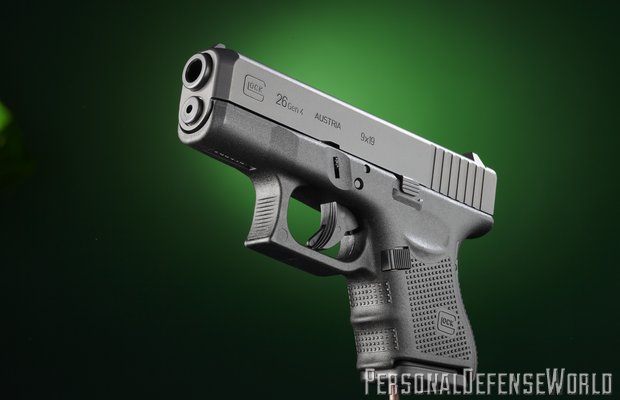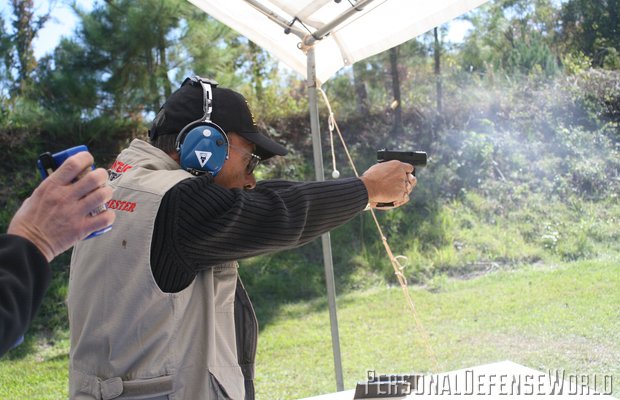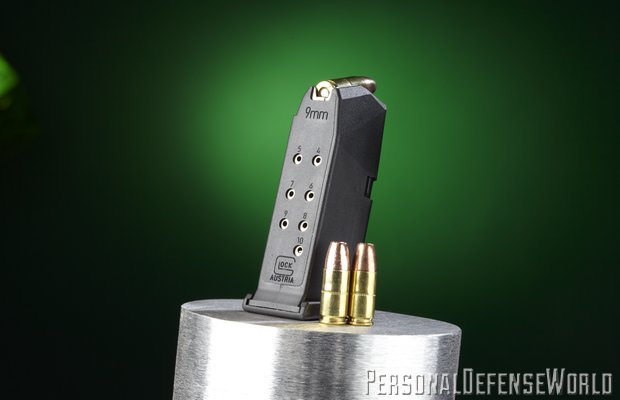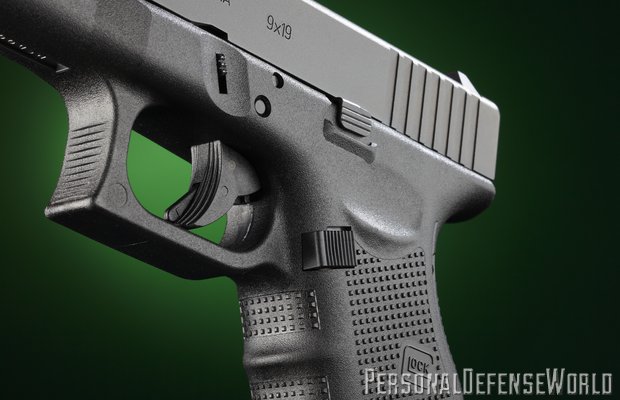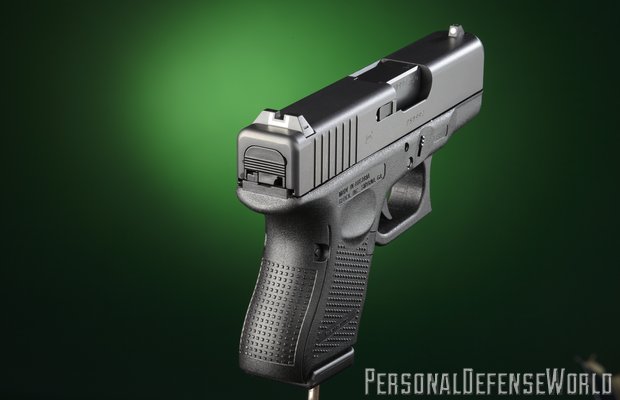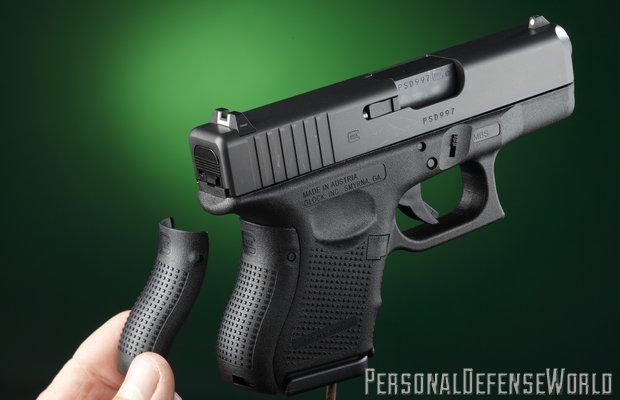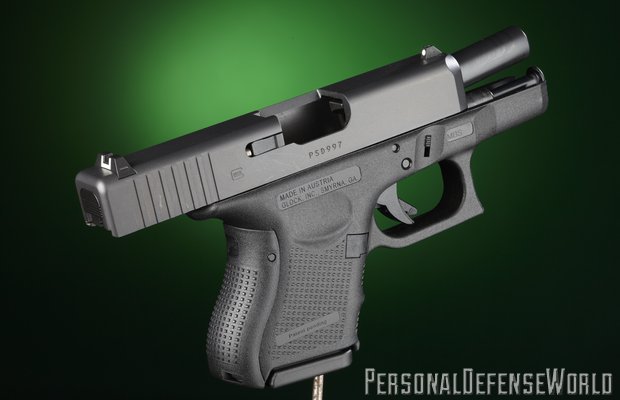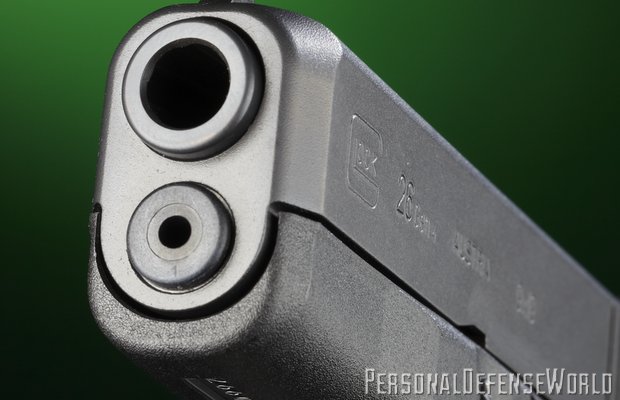In 1996, Glock introduced the subcompact “baby Glock.” It was originally offered in two models: the 9mm Glock 26 and the .40 Glock 27. In time, two other versions were added: the Glock 33, chambered for .357 SIG, and the Glock 39, built around the .45 GAP cartridge.
When the Glock 26 and the Glock 27 came out, I was immediately impressed by their reliability and “shootability.” Neither “kicked” in proportion to their size reduction compared to the full-size Glock 17 9mm and Glock 22 .40. When the test was over, I bought both pistols and kept them.
Big Performance
Advertisement — Continue Reading Below
What was most surprising with these little guns was that, off the bench, they “outshot” their big brothers. The primary Glock 17 I had at that time would group 3.5 to 4 inches at 25 yards with most loads, better than that with its favorite Winchester 115-grain ammunition…but my little Glock 26 delivered 2.5-inch groups at the same distance, with regularity. In .40 caliber, I saw the same thing. During 2002 and 2003, I was testing new uniform security holsters for my police department, and since the standard-size Glock was already the most popular police gun, I was given permission to carry the Glock of my choice. Since I worked in an area with long winters and had learned that any hollowpoint can plug and turn into ball if it has to pierce enough inert fabric such as winter clothing, I wanted something larger in caliber. I chose the Glock 22 as my service gun during that period. It made sense to carry a backup that would take not only the same ammunition but the same magazines, so the Glock 27 in the same .40 caliber became my backup gun when working for the department.
I couldn’t help but notice the same thing I’d seen with the full-size Glock versus the baby Glock in 9mm—the smaller one shot tighter from a 25-yard benchrest. One reason I carried Black Hills 165-grain EXP ammunition—which at that time was a Gold Dot bullet loaded to 1,140 feet per second (fps) velocity—was that it was not only dynamic in flesh and capable of passing the FBI Protocols, but it was also match-grade accurate. The Glock 22 was not the most accurate pistol Glock ever made, and with many loads, my specimen would only group around 4 inches or so. With the Black Hills duty loads, however, my groups shrank into the 2-inch range.
However, off the bench, my Glock 27 was about the same with the Black Hills round for grouping…tighter with most anything else…and once put five Winchester 155-grain Silvertips into a 1.5 inches off the bench at an Indiana class, in front of witnesses.
Advertisement — Continue Reading Below
I still tended to carry full-size Glocks as “primaries.” After all, their larger grip frames held longer magazines with more cartridges. Those same grip-frames afforded me room to get all the fingers of my firing hand wrapped around the pistol. The longer sight radius seemed more forgiving in rapid fire on multiple targets. I reserved the “Baby Glock” for when I had to conceal a gun under a tailored suit, and sometimes for backup when I was carrying a larger Glock in the same caliber as a primary weapon.
Recent input has made me reconsider the baby Glock’s “shootability”… and my preference for the .40 caliber Glock 27, and later the .357 Glock 33, over the Glock 26 and its long-maligned 9mm round.
GSSF Input
Advertisement — Continue Reading Below
GSSF, the Glock Sport Shooting Foundation (gssfonline.com) has for many years had separate classes for competition-style Glocks with 5.3-inch and 6-inch barrels, service Glocks with up to 4.5-inch barrels, and the subcompact baby Glocks. In the last couple of years, we’ve seen something very interesting happen with “the little ones compared to the big ones.”
We’ve seen the “snubnosed” Baby Glocks—in every such case, the 9mm Glock 26—win not just the Subcompact event, but the overall championship title that GSSF calls “Matchmeister.”
Now, I don’t recall ever seeing a major PPC match where a competitor with a snub-nosed revolver tallied the overall high score and beat all the shooters with long-barreled guns. I’ve never heard of a major IPSC/USPSA match where a guy with a stubby Colt Officers subcompact .45 ACP beat everyone who went into that competition field with a 5-inch barrel or even longer 1911 pistol. Nor have I ever heard of anyone winning the National Pistol Championship at Camp Perry with guns whose barrels were shorter than 5 inches in length, even though the shorter guns have always been eligible to compete. So, what’s going on in GSSF?
Advertisement — Continue Reading Below
Well, to start, you’ll generally have three matches to shoot with each category of pistol in GSSF. There’s “Glock the Plates,” where you face a Bianchi Cup array of six steel disks, each 8 inches in diameter, from a distance of 11 yards. On the signal, you come up from low ready, and the timer stops when you’ve shot your last plate down flat from 33 feet away. You’ll do that four times. You have 11 shots at your disposal, and can’t reload; if any plate is left standing when you go to slide lock, it’s an additional 10 seconds added to your time and score.
Then, you’ll have to deal with “Five to Glock.” Five tombstone-shaped Bianchi Cup targets will be arrayed in front of you at distances of, roughly, 5 to 25 yards. You’ll come up from low ready and fire two shots at each of the five targets. You get full value only for hitting the 8-inch-diameter center circle. A hit in the ring outside that costs you a second added to your time…a hit outside that ring means an additional 3 seconds…and missing the target entirely is a whopping 10-second penalty. You’ll make that run three times.
The third event (though you can shoot them in any sequence you choose) is the “Glock M.” Four cardboard Bianchi targets and a row of steel Pepper Poppers are arrayed in a shape that would look like the letter “M” when seen from above the range. The steel targets are in the middle. You have three runs of two shots on each of the four cardboard targets—same rules as “Five to Glock”—plus one steel target that has to be knocked down on each run.
Advertisement — Continue Reading Below
If you strike down every piece of steel with one shot, that’s a total of some 81 shots. If you can do it in under a 100 seconds, you’re generally perceived to be a darn good shot. And, if you can do it in less than half that time—and beat all the people with bigger guns, while you are using a baby Glock—well, that’s just phenomenal. It says something powerful about not only the shooter, but the little subcompact pistol the shooter used to perform that feat.
Read more about GSSF here!
Matchmeisters
Advertisement — Continue Reading Below
In 2010, I heard something about a shooter taking Matchmeister honors with a Glock 26 at a major GSSF match with hundreds of entries. It struck me as an oddity; “Here’s a guy so good, or so lucky, he beat the long-barrel shooters, Masters and all, with a ‘snubby.’”
It turns out it wasn’t that much of an oddity.
Danny Ryan is the moderator of the GSSF section at glocktalk.com. He keeps track of all things GSSF related, and he recently noted, “According to my unofficial records, Matchmesiter was won with a Glock 26 by: 41.51: Grady Whitelaw, Indianapolis, Indiana; 43.61 Mike Ross, Morganton, North Carolina; and 46.94 Jeff Bucci, Fulton, New York. Grady holds the record for low score of 38.92 with a subcompact Glock, Orlando 2008. In addition, there were several in 2010, including Tony Clemens.”
Advertisement — Continue Reading Below
Grady Whitelaw’s 38.92 second time for more than 80 shots on those difficult targets, and the times in the low to mid forty-second range posted by those other Matchmeisters, can perhaps best be put in perspective by those who’ve actually shot GSSF matches. Suffice to say, it’s phenomenal.
But it has happened often enough, it can no longer be seen as an anomaly. There’s something going on with the Glock 26 pistol that makes it disproportionately “shootable” in a tough course of fire, which demands both speed and accuracy. Let’s look at what those things might be.
Shootability
Advertisement — Continue Reading Below
Across the caliber range, as counterintuitive as it may seem, the smaller Glock pistols have proven themselves to be proportionally more accurate than the larger ones. Consider the .45 ACP Glocks. The big Glock 21 service pistol has been known to shoot groups of 1.5 inches or less for five shots at 25 yards. This may be because the .45 ACP cartridge has long been known to have a high degree of inherent accuracy, and it may be because .45 caliber Glock barrels are built differently than other caliber Glocks, the .45s having more “lands” in their polygonally rifled barrels than the others. I suspect it is a combination of both.
However, when the subcompact Glock 30 in caliber .45 ACP was introduced in 1998, eight years after the big Glock 21 in the same caliber, others and I noticed that it shot just a bit tighter than its big brother. I was able to twice get 5-shot groups of under an inch from 25 yards with the Glock 30, once using match-grade Remington 185-grain target ammunition, and once with 230-grain Federal Hydra-Shok hollowpoint duty loads.
It was totally counterintuitive that the smaller gun would be more accurate than the larger in the same caliber, but the same thing was going on with the Glock 30 compared to the Glock 21 as had been noted earlier with the 9mm and .40 baby Glocks shooting tighter than their larger counterparts. First, the shorter barrels were relatively more rigid than longer ones of essentially the same diameter. Second, and perhaps more important, all the subcompact Glocks from Glock 26 to Glock 30 had strong, double-captive recoil spring assemblies. These delayed the unlocking of the barrel and slide until the bullet was out of the muzzle and on its way to the target.
Years before, at the Smith & Wesson Performance Center, master gunsmiths like Paul Liebenberg had figured out that if the slide could be held forward until the bullet had departed from the muzzle, accuracy would be enhanced. They used different recoil springs to help achieve that effect. This was, essentially, the same principle that was going on inside the baby Glocks vis-à-vis their bigger siblings.
A shorter slide, with a shorter radius between the front and rear sight, should in theory produce less accurate shots. However, in the hands of a particularly skilled marksman, the shorter sight radius also allows faster realignment of the sights, from shot to shot.
Moreover, it is worthwhile to take a look at the backstrap, the rear surface of the grip-frame, of the baby Glock compared to its larger siblings. It seems to curve more at a spot that interfaces with the palm of the shooter’s hand. When firmly grasped, it mates remarkably well with the hollow of that palm, locking it into the hand’s grasp. This tends to lock the gun in place very solidly against front-to-back forces: the front-to-back pressure of the trigger finger, for example, and the front-to-back recoil from the previous shot, from which the shooter must recover to gain alignment for the next shot.
There are also some shooters who find that a shorter slide comes back on target for them faster. For some years now, I’ve had the pleasure of shooting on the same pistol team as Super Dave Harrington (currently the Panteao Gun Team). They don’t call him “Super Dave” for nothing. The guy is a helluva good shot. He has won his share of matches shooting a Glock 19 (4-inch barrel) against folks with Glock 17 (4.5-inch barrel) and Glock 34 (5.3-inch barrel) pistols.
Earlier, I mentioned Mike Ross. I’ve known him for many years. He’s one of the top GSSF shooters around, and he told me recently he prefers to shoot a 4-inch Glock 19 against the longer barrel guns. He finds the shorter slide brings the sights back on target faster for the next shot. When he’s running on tenths of a second or even hundredths of a second to beat the other shooters, that means something.
And, remember…he’s one of those guys who used a Glock 26 with 3.6-inch barrel to beat everyone with the bigger guns for the coveted Matchmeister title in GSSF…
Glock 26 Comparison
The frames and trigger reaches are identical on the Baby Glocks, Gen 3 and Gen 4. The caliber differences have to do with power, recoil, and of course, cartridge capacity, since larger caliber rounds with their greater diameters proportionally limit how many cartridges can be in the magazines.
Power will have to do with ammunition choice. Decades of studying gunfights had convinced me that the best 9mm ammunition is more effective than the worst .45 ammunition. In the true “baby Glocks” you have six in the magazine and one in the chamber with the Glock 39 in .45 GAP, nine plus one with the Glock 27 in .40 S&W or the Glock 33 in .357 SIG, and ten plus one in the 9mm Glock 26. How much difference will that make? Well, in the last analysis that will depend on how the gunfight goes.
Recoil? That definitely favors the Glock 26. As a general rule, .40 and .357 and .45 all “kick” more than 9mm. The hottest 9mm seems to kick no more than the mildest .40. At close range, if the shooter has a strong hold and is firing as fast as is humanly possible, there’s remarkably little difference in shot placement and speed between .40 and 9mm. However, as distances extend, the 9mm (Glock 26) comes back on target a bit faster than the .40 (Glock 27) and the other more potent baby Glocks. With the longer distances being between 20 and 30 yards in a GSSF match, it’s no wonder that the only baby Glocks that have won Matchmeister honors for their shooters at GSSF events have been Glock 26 pistols with their mild 9mm ammunition.
Prior to learning from Danny Ryan that several Matchmeister honors had been won with the little Glock against the bigger ones, I had thought it a fluke that in two GSSF matches in one year my scores had been better with a little Glock 26 than with a full-size Glock 17. As an experiment, at the end of October 2011 I shot the Glock match in Charleston, South Carolina with a Glock 26 in Competition division against the longest barrel Glocks, Master Stock against the Glock 17s and 19s, and the Subcompact division against the other baby Glocks. Bottom line? My scores in both Competition and Master Stock were better than what I had done in my last two GSSF matches using a full size Glock 17. It left me convinced that the Glock 26 was a more “shootable” defensive handgun than I had previously realized.
Versatility
Like all baby Glocks, the Glock 26 will take the longer magazines of its larger sibling guns in the same caliber, built for the same frame. You can get magazine sleeves that give the pistol the same feel as a larger Glock, or you can just use longer mags and let them hang out the bottom. It works for Mike Ross, it works for me, and it should work for you. Heck, the Glock 26 will run with the 33-round magazine that Glock designed for their Glock 18 machine pistol.
There are numerous sight replacement options and trigger pull options for the Glock 26 and other baby Glocks, including laser sights such as LaserMax and Crimson Trace. The one I shot in Charleston was box-stock insofar as sights and 5.5-pound trigger. Mike Ross uses Dawson sights, adjustable rear and fiber optic front, and that option is calling to me right now. The Glock pistol is second only to the 1911 in terms of aftermarket options for customizing. The recent introduction of the Gen 4 version, with larger magazine release for faster reloads and especially a shorter trigger reach and adjustable backstraps to fit the gun better to the user’s hand, only make the latest incarnation of the Glock 26 even better.
With modern 9mm ammunition, the ankle-holster-size Glock 26 has proven itself capable of shooting on pace with service-size and even target-size pistols in every respect. Friends at Glock tell me the Glock 26 is, right now, the best-selling of their subcompact pistols. I can understand why.
